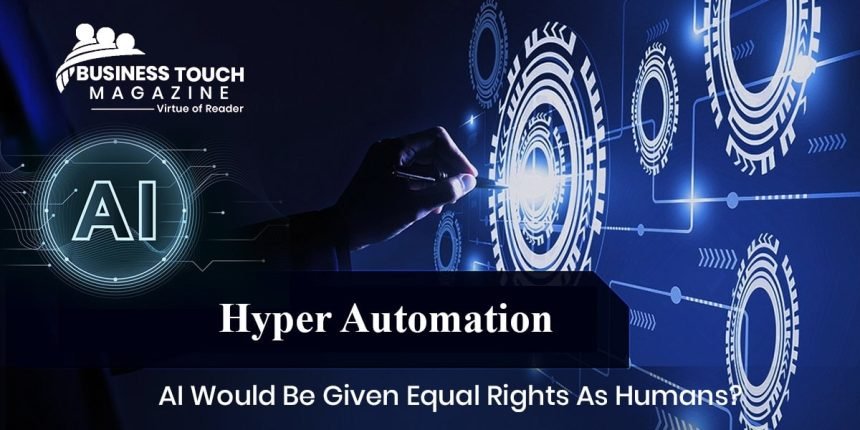Would you believe me if I told you in a few years AI would be given equal rights as humans? It’s already happening, have you heard about Sophia? She’s a humanoid robot that is powered by AI. She has her thoughts, and emotions, and can see and speak like humans, in 2017 she was granted legal citizenship in Saudi Arabia.
What is Hyper Automation?
It’s the extension of legacy business process automation beyond the confines of individual processes. By marrying AI tools with RPA, hyper-automation enables automation for virtually any repetitive task executed by business users. It even takes it to the next level and automates the automation – dynamically discovering business processes and creating bots to automate them. Hyper automation was identified by Gartner as one of the year’s top 10 strategic technology trends.
With a range of tools like Robotic Process Automation (RPA), machine learning (ML), and artificial intelligence (AI), working in harmony to automate complex business processes—including where subject matter experts were once required—hyper automation is a means for real digital transformation.
The Concept of Hyper Automation
At this point, we are all comfortable with what Automation is and what it can bring, but perhaps not everyone has heard about Hyper automation? It may sound a bit like science fiction, but it has real-life applications and more and more organisations are using it as we speak. Hyper automation is a broad term for the outcome of using and managing multiple automation technologies simultaneously and often using more than one platform and technology to automate a given process.
Typically, organisations that have taken the “low hanging fruit” of automating simple and standardised tasks, perhaps using Robotic Process Automation (RPA) or Intelligent Document Processing (IDP) tend to move on to more complex processes to automate that require a suite of technologies to succeed. It often, and increasingly, also involves technologies such as artificial intelligence (AI) and machine learning (ML).
Why is Hyper Automation Important?
Hyper automation provides organizations with a framework for expanding on, integrating and optimizing enterprise automation. It builds on the success of RPA tools and addresses their limitations. RPA owes its rapid growth, relative to other automation technologies, to its ease of use and intuitive nature. For example, because RPA mirrors how people interact with applications, employees can automate part or all of their work by recording how they perform a task. And because bots mirror human actions, the automated work tasks can be measured for speed, accuracy or other metrics used by companies to evaluate employee performance on the same tasks.
Hyper automation takes a step back to consider how to accelerate the process of identifying automation opportunities and then automatically generating the appropriate automation artifacts, including bots, scripts or workflows that may use DPA, IPA or cognitive automation components.
How does hyper automation work?
Rather than referring to one single, out-of-the-box technology or tool, hyper automation centres on adding more intelligence and applying a broader systems-based approach to scaling automation efforts. The approach underscores the importance of striking the right balance between replacing manual efforts with automation and optimizing complex processes to eliminate steps.
A key question lies in identifying who should be responsible for the automation and how it should be done. Frontline workers are in a better position to identify boring tasks that could be automated. Business process experts are in a better position to identify automation opportunities that are handled by many people.
Key Components of Hyper Automation
Hyper automation is somewhat of a broad umbrella. The term encompasses multiple Automation technologies, tools and Automation platforms, which is also what makes it such a useful concept. Chance is that you already are familiar with some of the technologies presented here. Let’s take them one by one.
1. Robotic Process Automation (RPA)
Robotic Process Automation is a software technology that helps you to automate repetitive tasks in business processes. RPA can be used for procurement, pricing, billing, quote request, follow-up, data input and system maintenance and repair. RPA software bots interact with any application or system similar to humans, with the exception that RPA bots’ function around the clock, significantly faster, and with complete dependability and accuracy.
2. Artificial Intelligence (AI)
Artificial intelligence (AI) is a diverse field encompassing predictions, categorisation and data mining. It is concerned with creating intelligent computers capable of undertaking actions that would otherwise require human intelligence. Machine Learning (ML), covered more below, is a very common one but AI is also very helpful for detecting patterns (data mining), advanced semantic analysis as well as supporting more advanced implementations of Natural Language Processing (NLP), AI algorithms can typically optimize processes by coordinating computing resources, analyzing historical and real-time data, and taking automated actions.
3. Machine Learning (ML)
The goal of Machine Learning is to make machines more intuitive and adaptable to changes. Machine learning allows computers and robots to make data-driven decisions, based on an algorithm being trained with human-verified data to take human-like decisions. This is instead of being specifically programmed to perform a particular task as with RPA.
4. Natural Language Processing (NLP)
Natural language processing (NLP) may feel as if it has been around for a long time, but only recently has it started to fulfil its potential as more and more computing power becomes available. Modern NLP enables computers to process and evaluate vast quantities of natural language data including semantics and context (e.g., if the word bass is seen in a text, is it about the fish or the sound frequency). This technology applies to both spoken and written input and is therefore tightly linked with voice recognition, chatbots and intelligent document processing (IDP).
5. Intelligent Document Processing (IDP)
Intelligent document processing is the more modern variant of what is commonly known as OCR (optical character recognition or optical character reader). It is the electronic or mechanical translation of pictures of typed, handwritten, or printed text into machine-encoded text. The source of the text could be a scanned document, a snapshot of a document or subtitle text overlaid on an image. Hyper automation can help your organization
Hyper Automation Benefits
Although requiring some upfront investment and capabilities within a suite of automation technologies, Hyper automation can significantly reduce company costs also in really complex processes. It may even improve security and free up internal resources.
- Improve decision making.
- Optimize workforce engagement.
- Combining traditional automation with low/no-code.
- Increase agility.
- Acceleration and accuracy.




